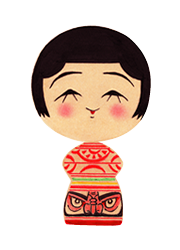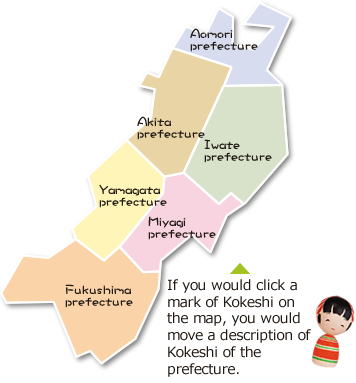
Yukinori Jinnohara who is making Kokeshi in the Tsuchiyu hotsprings where is the birthplace of the three major Kokeshi says that Kokeshi has been originally maden by craftsman who was called " Kijishi ".
Kijishi made bowls and wooden household goods which were used in their daily life, in hotsprings in Tohoku region. At first they made toys for children since the end of Edo Era and later this became the souvenir for people of a hotsprings.
Nowadays, the craftsman who make Kokeshi are called " Kokeshi Kojin " and Kokeshi are divided into the eleven categories according to their shape and their design.
Lyrics, melody,singer Reiko Matsumoto
Arrangement, recording Toshiaki Sudo
Traditional eleven categories Kokeshi which were born in Tohoku region.
A joyful melody of music on which all Kokeshi have the features.
A concept of " be known by many people widely" , this song was made for the thought.
The feature of Kokeshi is easy to learn and just humming " Poppyn! Poppyn..."
Let's sing this joyful and happy "Kokeshi caregory song!


One of the three major traditional Kokeshi origin. The head is small and mounting system, when rotating the head, make a squeaking sound. There is a design of black snake on the head and a big forelock, designed comb on the hair at the temples, a face is drawn with the eyes of whale and a drooping nose and a small mouse. A trunk is thinly, the feature is a horizontal-stripes pattern of a delicate neck.
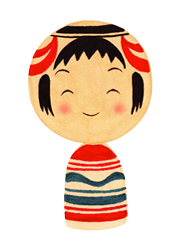

It is said that it is a little younger than Naruko origin and Tohgatta origin which are the three major Kokeshi. The head is large mounting system and the feature is a long neck of many colors like a beret. It has a womanlike form in a trunk, the collar and the skirt are simply designed on the long neck pattern.
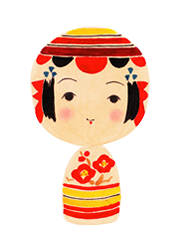

One of the three major Kokeshi along with Naruko origin and Tsuchiyu origin. The head with a mounting system is big. The radiate red decoration called Tegara is designed on the Okappa head, Japanese traditional children hair style. The feature are slit eyes, a thin trunk of sloping shoulders, layed chrysanthemum and the grain pattern.
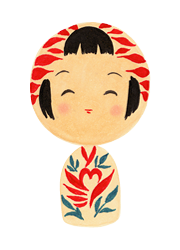

One of the three major Kokeshi origin along with Tohgatta and Tsuchiyu. The head is a mounting system and make a squeaking sound when rotating the head.
The feature is the front hair which is binded with " Mizuhiki ". A middle trunk is thin, shoulder and skirt are streched, and gorgeous patterns like chrysanthemum are drawn.
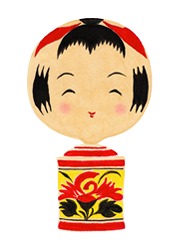

On a basis of the skill came down from Tohgatta, it developed uniquely affecting from Yamagata origin. The feature is a small head with the mounting system, a thin trunks which children used to play. And also the form of a skirt of a trunk was squeezed and patterns called " Kani kiku ".
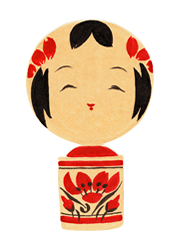

It is said that the origin has been a mixture with Naruko and Tohgatta which are one of the three major origins. The head is a mounted system and the feature is a smile from ear to ear. They have a thick straight trunk with stretched and layed shoulders and many flowers like" Kasane Kiku " and " Nadeshiko, pink ".
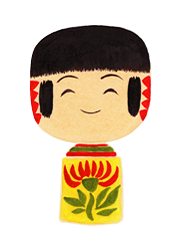

It is said that " Mokujishi " who learned in Sakunami, is also a small mounted head like Sakunami and the feature is thin body like a stick. There are red decoration on head and hair which pierce through a center, a characteristic split nose , main patterns of a trunk are safflower, peony, chrysanthemum,
and Japanese apricot.
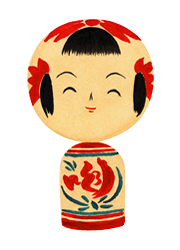

It is said that it has been affected from Togatta origin. A mounting head is big and has radiative red decorations and many " Okappa " head.
Carried out cherry tree patterns, layed chrysanthemum patterns and peony patterns are drawn on a massive body.
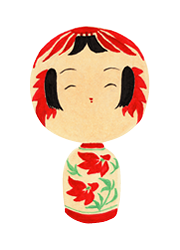

" Tsukuritsuke " method which a head and a trunk are made from one wood. The head is like a shallot. A large front hair with a red decorated cloth and " Okappa " hair are drawn. A trunk is thick and massive, also fall foward patterns of a plum flower on a vertical stripes "Kimono ( Japanese cloths ) " is main patterns.
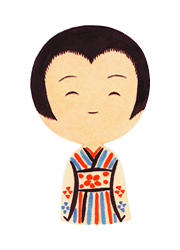

A head is a gentle plug-in system, so it moves smoothly. It is said that pacifier called " Kinakina " has been developed to " Kokeshi ", and the feature is colorless. There are drawned layed chrysanthemum and a bib pattern but main style are artless and primitive pattern.
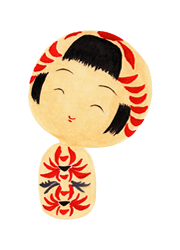

" Tsukuritsuke " method which the head and a trunk are made from one wood. There are mainly " Okappa " head and wide skirt. A trunk with a swelled breast is a hot springs " Kokeshi " typically. There are also peony patterns which is the crest of " The Tsugaru Clan ", pattern of " Ainu race " and " Nebuta picture ".
